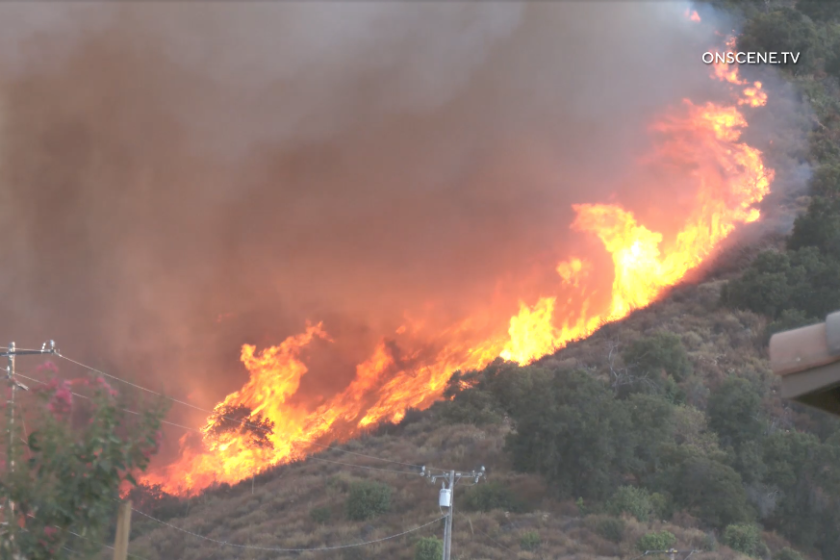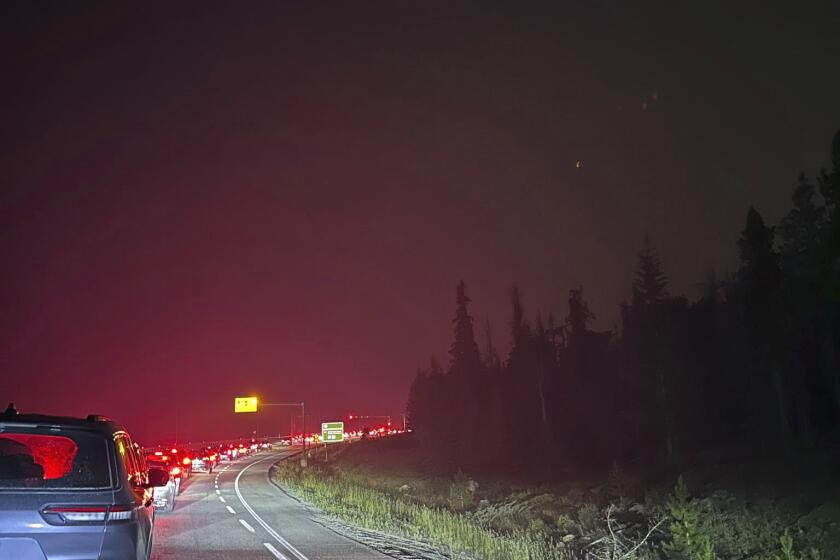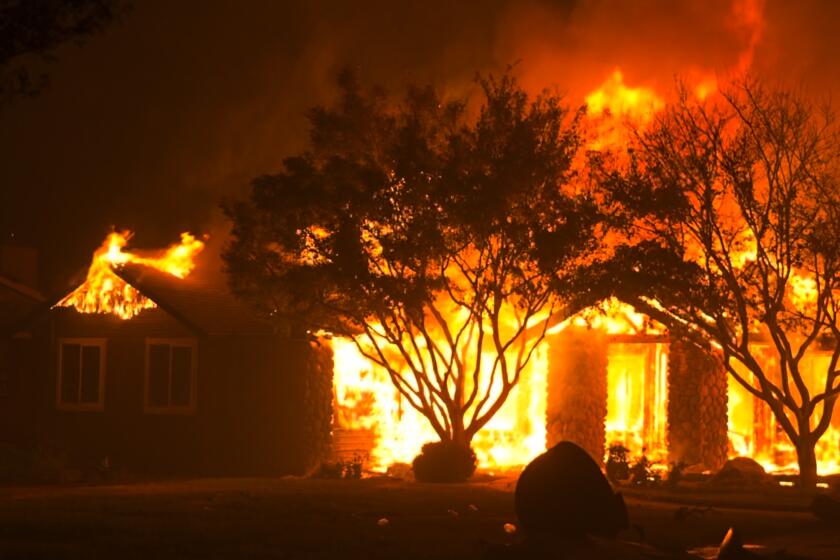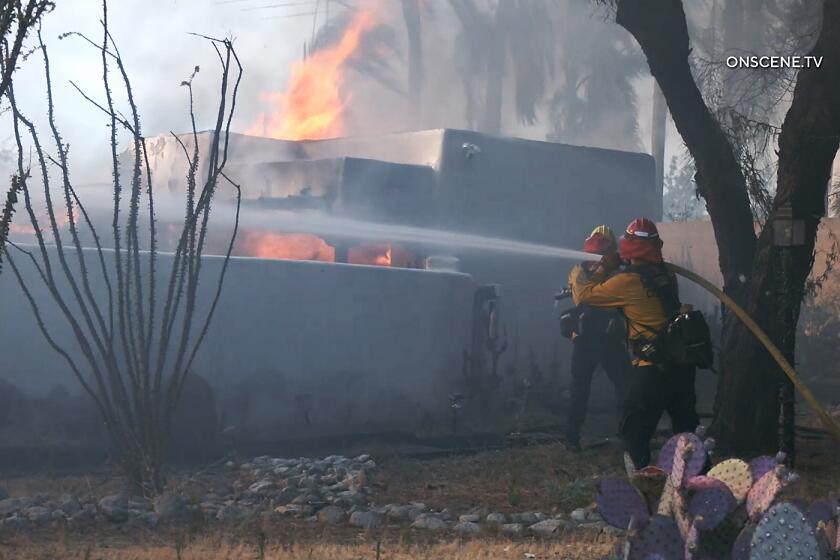Here’s the Scoop : The Super Scooper, Los Angeles County’s Newest Firefighting Weapon
After last year’s wildfires, the Los Angeles County Fire Department has temporarily added two new weapons to its firefighting arsenal: a pair of amphibious aircraft known as Super Scoopers.
Through a unique partnership between the county and insurance companies, the Canadian-made aircraft have been leased from the Quebec government for a three-month trial.
The Super Scoopers are able to carry three times as much water as the county’s firefighting helicopters and need not land to replenish their water supply. Ten seconds of contact with the surface of a nearby lake, reservoir or even the ocean is all that is needed between drops. The plane’s ability to fly in narrow canyons make it ideal for battling fires in Southern California.
County firefighters first used the planes, based at Van Nuys Airport, on a recent grass fire in the Antelope Valley.
A Look at California’s Ties to the Super Scooper 1970: Canadair, the plane’s manufacturer, volunteers a CL-215 to fight Berkeley fires. Los Angeles County requests use of the plane to help fight fires in Malibu. After three days, the aircraft are returned because of contractual disputes with other fixed-wing firefighting aircraft.
1979: Two planes are tested for 2 1/2 months by Los Angeles County Fire Department, helping fight Laurel Canyon fire in September.
1980: Ballot initiative aimed at purchasing two aircrafts fails to get required two-thirds vote.
1982: Legislation introduced to authorize state purchase of two CL-215s. In October, two aircraft are leased for testing by forestry department.
1991: After destructive Oakland and Berkeley Hills wildfires, Assemblyman Terry B. Friedman (D-Brentwood) introduces legislation to lease two Super Scoopers for 1992-93 fire season.
1992: Legislation passes state Assembly and Senate, but is vetoed by governor.
1993: After disastrous wildfires in Los Angeles, Ventura and Orange counties, Friedman tries again to get state approval to lease two Super Scoopers for 1994-95 season.
June, 1994: Friedman legislation passes Assembly.
August, 1994: Friedman legislation passes Senate.
September, 1994: County Board of Supervisors votes to fund leasing of one CL-215 for up to three months beginning in October. Gov. Wilson signs law enabling state to lease two Super Scoopers for 1995 and 1996 fire seasons.
October, 1994: Canadair provides two planes for testing and evaluation. California insurance industry contributes to funding.
*
* Dimensions: Length 65 feet; wingspan 94 feet; height 29 feet
* Weight: 43,850 pounds
* Fuel capacity: 1,530 gallons
* Water storage capacity: Two tanks hold 1,410 gallons.
* Foam storage capacity: Two tanks hold 159 gallons.
* Airspeed when scooping: 100 m.p.h.
* Capability: Scoops 1,400 gallons of water in 10 to 12 seconds. Plane can fly four hours before refueling.
* Crew: Two Canadian pilots and one from L.A. County Fire Department
* Cost: Leasing over three months for $719,000 for two crews and mechanics, plus $515 an hour in flight. Purchase price for one plane is $16.5 million.
* Pontoons give plane stability
* Excess water drains out of baffle
The Scoop
The county Fire Department has identified up to 15 local bodies of water from which the pla e can scoop, including the ocean. The body of water must be at least 4,000 feet long, 300 feet wide and six feet deep. It can scoop in head winds to 45 m.p.h. and waves to five feet. Pilots change technique in high-wave conditions, scooping across crest of waves instead of bouncing from wave to wave. Here’s what takes place:
1. As plane skims water at 100 m.p.h., pilot lowers the two 3-by-5-inch scoops. (A)
2. Water rushes through scoops into two storage tanks (B).
3. In about 10 seconds, tank is full and plane rises off water.
The Drop With small spotter plane leading the way, the Super Scooper begins its drop of water or water and foam from as low as 150 feet. Foam is often used ininitial attack on a fire. It is a soapy concentrate that helps water “cling” to vegetation. 1. Pilot opens water drop doors, releasing water onto fire. 2. If foam is used, pilot uses control that injects foam concentrate from its storage tank (C) into water tank. Upon release, mixture puffs up to 25 times its volume.
Sources: Canadair; Los Angeles County Fire Department
Researched by JULIE SHEER / Los Angeles Times
More to Read
Sign up for Essential California
The most important California stories and recommendations in your inbox every morning.
You may occasionally receive promotional content from the Los Angeles Times.






